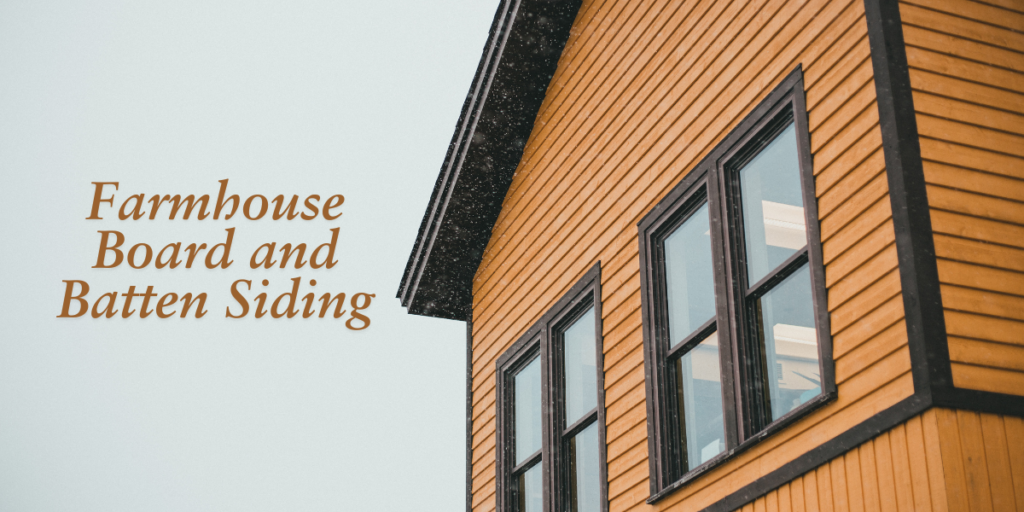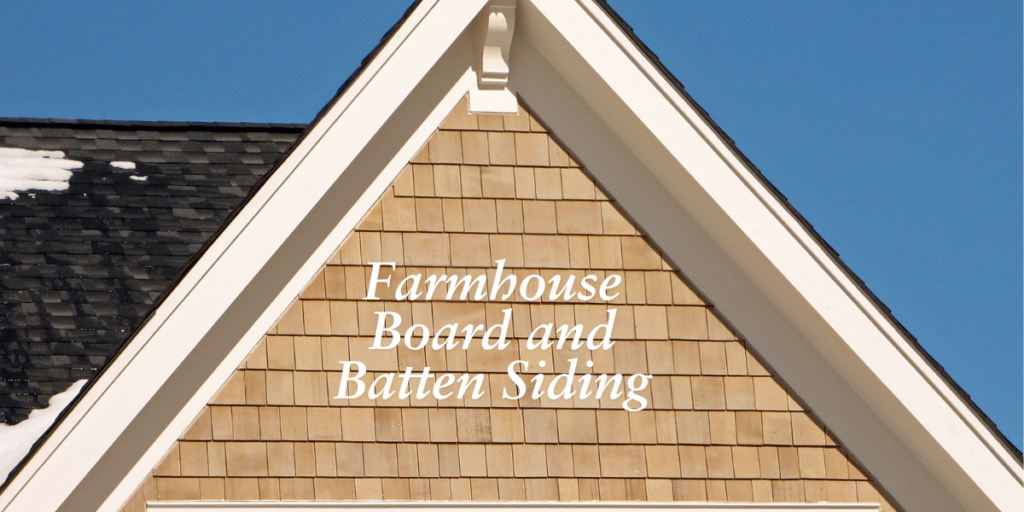Farmhouse Board and Batten Siding: A Step-by-Step Guide to Design and Setup
Farmhouse board and batten siding has become a timeless choice for homeowners looking to add rustic charm and modern elegance to their property. With its origins in traditional architecture, this style has found a renewed interest in contemporary home design, especially in rural and suburban settings. In this guide, we’ll explore what farmhouse board and batten siding is, its benefits, installation tips, and how it can transform the exterior of your home.
What is Farmhouse Board and Batten Siding?

Farmhouse board and batten siding is a vertical siding style consisting of wide wooden boards with narrow wooden battens placed over the seams where the boards meet. This method not only enhances the aesthetics of a home but also helps protect the structure from the elements. Traditionally, this style was used in barns and farmhouses, hence its name. Today, it is popular in a variety of architectural designs, offering a blend of rustic and contemporary appeal.
The History Behind Board and Batten Siding
The board and batten technique has been used for centuries, originating in Europe. Early settlers in the United States adopted this style due to its durability and simplicity. The method involved using large wooden planks for walls and then adding battens over the joints to prevent wind and rain from penetrating. Over time, the aesthetic qualities of this design, combined with its functional benefits, made it a staple in rural architecture. Modern adaptations of this style have evolved to incorporate various materials, finishes, and colors.
Why Choose Farmhouse Board and Batten Siding?
Farmhouse board and batten siding offers numerous advantages for homeowners looking to upgrade their property. Some of the most significant benefits include:
1. Aesthetic Appeal
The vertical lines of board and batten siding create an elongated effect on a building, making it look taller and more dynamic. The distinct combination of wide boards and narrow battens gives the exterior of your home a unique, charming look that stands out in both rural and suburban settings.
2. Durability and Protection
The use of wood or composite materials in board and batten siding provides a robust barrier against the elements. The overlapping battens ensure that rainwater runs off effectively, preventing water damage and promoting the longevity of your siding. It’s a great option for areas with harsh weather conditions, as it offers reliable protection against wind and moisture.
3. Versatility
While traditionally associated with rustic farmhouse-style homes, board and batten siding can be adapted to a wide range of design aesthetics. Whether you prefer a modern farmhouse, a traditional cottage, or a coastal style, farmhouse board and batten siding can be customized to fit your vision.
4. Increase Property Value
Adding farmhouse board and batten siding to your home not only enhances its curb appeal but also increases its resale value. Buyers are drawn to the timeless appeal of this style, making it an attractive investment for homeowners.
Materials Used for Farmhouse Board and Batten Siding
When considering farmhouse board and batten siding for your home, it’s essential to choose the right material. The most common materials include:
1. Wood
Wooden board and batten siding is the traditional choice for this style. It offers an authentic look and can be customized with various finishes, stains, and paints. Common wood options for board and batten siding include cedar, pine, and redwood. While wood provides a natural, rustic aesthetic, it requires regular maintenance to prevent rot, warping, and discoloration.
2. Vinyl
Vinyl board and batten siding is an excellent low-maintenance alternative. Vinyl is resistant to weathering, fading, and pests, making it ideal for homeowners looking for durability without the upkeep of wood. It’s available in a variety of colors and textures, allowing you to replicate the look of wood siding without the associated maintenance.
3. Fiber Cement
Fiber cement is also a popular choice for board and batten siding. This composite material combines cement, sand, and cellulose fibers to create a durable, fire-resistant, and low-maintenance siding option. Fiber cement board and batten siding mimics the look of wood while offering enhanced durability and longevity.
4. Engineered Wood
Engineered wood is a cost-effective and sustainable option for board and batten siding. It’s made from wood fibers and resin, which are compressed and bonded to create a sturdy material that is resistant to warping and splitting. Engineered wood provides the look of real wood but requires less upkeep.
Installing Farmhouse Board and Batten Siding
Installing farmhouse board and batten siding requires thoughtful planning and meticulous attention to detail. While it’s a project that can be tackled by skilled DIYers, many homeowners choose to hire a professional contractor to ensure the job is done correctly. Here are the key steps involved in the installation process:
1. Preparation
The first step is to prepare your home’s exterior by removing old siding, checking the underlying structure for damage, and ensuring the surface is clean and level. Proper preparation is crucial to ensure that the new siding is installed correctly.
2. Measuring and Cutting
Accurate measurements are vital for a successful installation. The boards need to be cut to fit the dimensions of your home. If you’re working with wooden boards, it’s important to ensure they are cut properly to avoid any gaps or misalignment when installing the battens.
3. Attaching the Boards
Start by attaching the vertical boards to the wall, ensuring they are spaced evenly. This is typically done using nails or screws. The boards should be attached securely to the framing of your home.
4. Placing the Battens
After installing the boards, the battens are applied over the seams to conceal the gaps. The battens help seal the joints and create the signature look of farmhouse board and batten siding. Ensure the battens are evenly spaced and firmly secured.
5. Finishing Touches
Once the boards and battens are installed, apply the desired finish. If you’ve chosen wood, you may want to stain or paint it to protect it from the elements. Vinyl and fiber cement materials typically don’t require additional finishing.
Design Tips for Farmhouse Board and Batten Siding

Farmhouse board and batten siding can be tailored to match your unique style. Here are a few design tips to consider:
1. Color Choices
While traditional farmhouse siding is often white or natural wood, modern variations incorporate a wide range of colors. Darker shades like charcoal gray or navy blue can add a contemporary touch, while light pastel shades can create a more relaxed, coastal vibe.
2. Complementing Architectural Features
Consider the other elements of your home’s exterior when choosing board and batten siding. If you have a lot of ornate features, such as crown molding or decorative windows, opt for a simpler board and batten design to keep the focus on these details. For a more minimalist approach, choose a clean, symmetrical design.
3. Adding Texture
Farmhouse board and batten siding works well with various textures. You can combine it with stone or brick for added visual interest. Alternatively, pairing it with a metal roof can enhance the industrial feel of your home.
Common Mistakes to Avoid When Installing Board and Batten Siding
While board and batten siding can elevate your home’s exterior, there are a few common mistakes that can compromise its longevity and aesthetic appeal:
1. Incorrect Spacing
Improper spacing between the boards or battens can lead to an uneven appearance. Ensure that the gaps are consistent to maintain a clean, professional look.
2. Neglecting Maintenance
Wooden board and batten siding requires regular maintenance to prevent rot and damage. Failing to maintain your siding can lead to costly repairs down the line.
3. Using Low-Quality Materials
Investing in high-quality materials is crucial for ensuring the durability and longevity of your siding. Cheaper materials may not provide the same level of protection and can result in premature wear.
Frequently Asked Questions
1. How much does farmhouse board and batten siding cost?
The cost of farmhouse board and batten siding varies based on the material chosen. On average, wood siding can cost between $5 and $12 per square foot, while vinyl and fiber cement are typically more affordable, ranging from $3 to $7 per square foot.
2.How long does board and batten siding last?
The durability of board and batten siding varies based on the material used. Wood siding typically lasts 15-30 years, while vinyl and fiber cement siding can last 40-50 years with proper maintenance.
3. Is board and batten siding energy efficient?
Yes, board and batten siding can help with energy efficiency when combined with proper insulation. The overlapping design provides an extra layer of protection, reducing heat loss in the winter and keeping your home cooler in the summer.
4. Can board and batten siding be installed over existing siding?
In some cases, board and batten siding can be installed over existing siding, but it’s crucial to ensure that the underlying structure is solid. If the current siding is damaged or deteriorating, it’s best to remove it before installing new siding.
5. Does board and batten siding require a lot of maintenance?
Wooden board and batten siding requires regular maintenance, such as painting or staining, to protect it from the elements. Vinyl and fiber cement options are much lower maintenance, requiring occasional cleaning but no painting or sealing.
Conclusion
Farmhouse board and batten siding is a versatile, durable, and aesthetically pleasing option for homeowners looking to enhance their home’s curb appeal. Whether you choose traditional wood, low-maintenance vinyl, or fiber cement, this siding style offers a timeless look that will never go out of fashion. By understanding the benefits, installation process, and design options, you can make an informed decision about incorporating board and batten siding into your home.












Post Comment